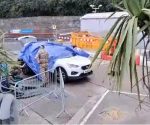Ahmed Hassan’s “bomb” a decoy – Parsons Green explosion appears to originate from elsewhere
Foster parents Penny and Ron Jones were on ITV’s This Morning this week, telling its drooling daytime audience that they loved Ahmed Hassan, even though they never seemed to take him on any of their many holidays. They readily apologised to the “victims” of the “Cartoon Jihadist”, the supposed bucket-bomber of Parsons Green, and stated their surprise that he had taken advantage of one of their vacations to turn their kitchen into a weapons laboratory. Ron, to his credit, said “I’ll be honest with you, I still can’t think he’s done such a thing.”
Does Ron Jones know that he and his wife just don’t have the equipment in the house for Hassan to have manufactured TATP (triacetone triperoxide), the explosive that Hassan’s device was supposed to have been composed of? Not likely; if you’re watching darts on the TV when armed police come around mob-handed to investigate you, then you probably aren’t interested in that sort of thing. All the same, Ron’s gut feeling is correct. Hassan did not bomb the tube train at Parsons Green station, 15th September, 2017. The incident was a hoax.
The trial of the “Cartoon Jihadist” took place over the last fortnight, and it appears to have been more detached from reality than the event that completely buried it in terms of corporate-news priority – that other hoax, the “Skripal” poisoning. The prosecution was able to convict based on the myth of back-room TATP cooking – which means that the trial was nothing more than yet another piece of theatrics courtesy of the British Establishment.
Prosecutor Alison Morgan said this:
The partial explosion caused a large fireball. Some in the carriage were caught by the flames and sustained significant burns, many ran in fear and panic.
This fireball was evidenced in CCTV footage from the tube train – which formed part of a bevy of material that only became available after the start of the trial. Previously, the author thought that witnesses who spoke of a fireball must have been lying – for a good reason that will be covered shortly. But the author didn’t count on the downright cunning of the people who evidently turned the carriage into a stage set.
The bomb was purported to be a device consisting primarily of 300g of TATP in a Tupperware container of the type that has a lid that can be removed completely. This lid had a hole in it, and the entire component was wrapped in tinfoil. Another 100g of TATP was held in a glass vase, and both this and the Tupperware box were placed inside a plastic builder’s bucket. Going by information that came out at the trials of other similar cases (see FBEL article Parsons Green terror theatre: using redeployed Mid-East battlefield assets?), the hole was likely meant for exposing the TATP to a fairy-light which would provide the impetus for a detonation. The remaining component to mention is an electronic timer by which one boils eggs; this would evidently trigger the fairy-light at a given time, and ultimately cause the explosion. Basically, then, the Tupperware container system acted as a detonator, although it involved a greater amount of TATP than was packed in the vase, nominally the main part of the bomb.
Presumably, the glass that encased this smaller amount of TATP was supposed to splinter into shrapnel – the bucket also contained various metal objects designed to meet the same purpose. The reason that the shrapnel was not propelled through the train carriage, said the prosecution against Hassan, was because the bomb did not work properly. It only partially exploded. Previously, it was understood that this meant that the detonator had worked, but had failed to set off the rest of the explosive (see the FBEL article mentioned immediately above). This is what appears to have happened after all. If the reader hasn’t paid the fee, then he cannot read the Times article that relates this information. However, the Google search result extract associated with the piece reads as follows:
The court heard that Hassan got off the train two minutes before the explosion and switched trains four times on his way to Dover, changing into a Chelsea [shirt?]… An explosives expert from the Forensic Explosive Laboratory, who examined the device at Parsons Green, said that the detonator had worked.
At the time of the attack, most expert voices were talking about a high explosive as the detonator, as this extract from a September 15th Express article shows:
Bomb expert Chris Hunter, who advised the Government’s Cobra committee after both the 7/7 and 21/7 London terror attacks, said the detonator itself would have been a high explosive and enough to create a small explosion in itself.
But from other information, it appeared that the detonator – meaning a small primary charge that would trigger the main explosive material – was itself fashioned from TATP, and this is what was reckoned to be the case in these pages. At FBEL, it was concluded that if partial explosion was referring to the detonation of the primary charge, then being composed of TATP, it should not have produced the fireball. The information that has come out in the trial tells us that the “detonator” comprised the most part of the bomb. If it had gone off, then the entire system would have been successful. However, when TATP explodes, it does not produce a fireball. It does not produce heat or light. The explosion of TATP is said to be “entropic” because its state changes from solid to gas; this decomposition produces raw energy. That’s why “Hassan’s bomb” had shrapnel in it – to harness this production of energy, and ride the blast wave, so to speak.
This sort of information about TATP is documented in Nick Kollerstrom’s book Terror on the Tube, and is the result of consultation with various experts (parts of the book are viewable at Kollerstrom’s web site). However, this is what the New Scientist magazine had to say about TATP in 2005:
An explosive sometimes used by terrorists does not burn when it detonates. Instead, its molecules simply fall apart. The chemist who has discovered this is so concerned by its implications that he has decided to abandon this line of research.
Triacetone triperoxide (TATP) has been used by suicide bombers in Israel and was chosen as a detonator in 2001 by the thwarted “shoe bomber” Richard Reid. Now calculations by Ehud Keinan from the Technion-Israel Institute of Technology in Haifa show that most of its explosive force comes from a rapid release of gas rather than a burst of energy.
In conventional high explosives such as TNT, each molecule contains both a fuel component and an oxidising component. When the explosive detonates, the fuel part is oxidised and as this combustion reaction spreads it releases large amounts of heat almost instantaneously.
TATP molecules are made up of fragments that could react in a similar way. But Keinan says that videos showing samples of TATP being detonated show that it can do so without producing any flame.
The ball of flame that is evidenced by the CCTV footage could not have been caused by Hassan, which makes his “bomb” a decoy, because obviously the fireball did occur. There are two reasons why we can say this, which are:
1) TATP is not simple to make, as expert witness for the prosecution in Hassan’s case claimed. Hassan, if he did indeed construct this “bomb”, undoubtedly could have only been able to create a dud that would never have exploded.
2) The explosion that is seen on the CCTV appears to emanate from high up on the wall of the train – above the heads of passengers. Hassan’s “bomb” was placed on the floor of the train carriage.
To make TATP, a would-be terrorist needs to operate on pure hydrogen peroxide to a 70% state of refinement. It cannot be purchased like this – nor can it be purchased as a household item, pure and at a state of refinement that is anywhere remotely near 70%. This figure is from Kollerstrom’s book, where it also supposes that one could only do this and know that a potentially explosive concentration had been produced by using distillation equipment. However, the coverage of Hassan’s attempt to make a bomb appears to suggest that he tried to boil water off the hydrogen peroxide in a saucepan.
The jury heard that a search of the house in Cavendish Road found traces of TATP on the kitchen hob and extractor fan, as well as on a ruler and Tesco Clubcard found in a black binbag in the house’s conservatory.
As the reader can see, the extract claims that TATP was being made on the kitchen stove – which would be too stupid to contemplate, for reasons that we are about to discover. The author cannot find reportage that retails how Hassan was able to refine his hydrogen peroxide, and so we should see this information about the TATP as a catch-all that suggests the idea of manufacturing having taken place without having to go into any detail; an entirely necessary journalistic and legal theatrical device, because he wouldn’t have been able to manage it. In fact, the prosecution even argued, rather oafishly, that Hassan did not test any of the explosive that he reputedly manufactured. It was meant as a rebuttal to a claim by the defence that Hassan was trying to build a mock bomb, for which he would need to experiment to test potency. Hassan could have had no idea that he had made hydrogen peroxide at the right strength.
To mix the other ingredients of TATP in with the hydrogen peroxide, one requires the means to keep the solution at a temperature of -10°C, and a means to extract the horrible fumes that are created. A refrigerated fume cupboard would have been ideal, but Hassan didn’t have one of those. As far as the author can make out, when the chemicals required to make TATP are mixed together, if the temperature becomes too warm, there is a premature explosion. Furthermore, TATP in its finished form is said to decompose explosively. The author doesn’t quite understand if this refers to simple evaporation – meaning that conditions to cause evaporation will cause explosion. However, there does seem to be an idea that even the UK Establishment subscribes to, and that is that TATP needs to be kept cool when it is being delivered to its target. This is presumably why Hassan’s bomb was put in a Lidl freezer bag. To use the language of the British Government in the Skripal case, it is highly unlikely that Hassan could have delivered a proper TATP bomb in the manner he did without it exploding. It’s certain that he couldn’t have even made a proper TATP bomb.
Instead of getting into any of this, the defence wanted to argue about the difference between deflagration and detonation. The argument was that Hassan had made the bomb without attaching the lid on the Tupperware container so that there wasn’t enough pressure in that vessel for detonation. Instead, the material burned rapidly. Well, this is nonsense. TATP doesn’t burn, it falls apart into a gas. Trying to light it would presumably cause it to detonate, and it wouldn’t matter if it was pressurised or not.
But it is interesting nevertheless that the defence brought this up, because the actual explosion does appear to be a rapid consumption of a combustible. The one obvious victim of Parsons Green, Victoria Holloway (she who had her ears bound up like a 1930s cartoon character), likened the explosion to the lighting of a Bunsen burner – and this would be an accurate description.
I heard a really loud bang and then I heard a whoosh – like the sound of a Bunsen burner when you light it. The flames were around my legs, and then they seemed to be sucked away from me.
It turns out that witnesses weren’t lying about a ball of flame. Any viewer of the CCTV footage is indeed able to see for him or herself a large burst of fire that appears and recedes very quickly, before it channels into a big lick of flame that bubbles near the ceiling briefly before whatever fuel it is combusting runs out. Interestingly, an expert witness for the prosecution, Sarah Wilson, told the court that “we looked at the carriage. There was no obvious explosive damage to the carriage itself. There was sooting in the ceiling.” And yet she somehow managed to see this as a sign of a TATP explosion. 17 years experience, apparently. Letting the gas escape on the kitchen hob a bit too long before lighting it creates this same kind of effect as was seen on the carriage CCTV – pointing to a combustible burning off. Indeed, to the author it looks like a dust explosion. It’s rapid, and cannot burn very hot, because it does engulf passengers, and they don’t ignite. Nobody leaves the carriage on fire as far as we can see. There doesn’t appear to be any kind of significant blast wave, either, because no one appears to be thrown over by the explosion. Arguably, the one or two people who find themselves on the floor have staggered backwards. Indeed, one passenger appears to move to try and duck the fire as it reaches him.
Crucially, the explosion appears to have come from above passengers’ heads. Closer inspection of the video shows that just before the appearance of the fireball, a spurt of a dark material shoots downwards from up on the train wall or the ceiling. Still images for the reader’s scrutiny are housed in a page entitled Parsons Green: the anatomy of an explosion – to be found here.
This dark matter could be the combustible material that was expelled from wherever it was being contained (with a small detonation) to then be ignited. It’s either that or smoke from the detonation of the device that would create the fireball. Whatever it is, it must be a theatrical special effect, and it definitely appears to come from above, not the floor where Hassan’s decoy has been placed. Indeed, if the reader looks at the 6th image in Set B, it is possible to see what looks like the first appearance of flame occurring in the top-right corner of a space that the reader is urged to focus attention on – in short, it happens up towards the ceiling.
Ahmed Hassan gained the epithet “Cartoon Jihadist” at FBEL because prior to the trial, there was not one photographic image of him available – which was quite unusual. After the trial opened, there was an inundation of imagery. There is more to be said about this (not least because it shows that he could well be in his early to mid twenties) – but that is for another time. It suffices to say right now that although there is a veritable smorgasbord of photos of Hassan on various trains, there isn’t a single one of him on the train that stopped at Parsons Green. Neither is there an image of him delivering the bomb. On the other hand, there is an image of him carrying the Lidl bag through Wimbledon station (below), supposedly on his way to catch the train bound for Parsons Green – but if there is a bucket in that bag, then Ahmed Hassan is not a patsy. (Incidentally, the image of the bucket on fire is entirely new and was not available before the trial). A viewer of this picture should ask himself what is it, exactly, that is meant to be in the bucket that would be burning in this very clean and smokeless way).
Before we end, because this article represents a return to business as normal, a word must be had about how the Skripal incident had generated an uptick in traffic to FBEL – which has also tended to drain away pretty fast also. It seems there isn’t an ability in the general public to relate the obvious Governmental operation around the Skripal “poisoning” with other historical and current incidents that demonstrate that Government psyops are frequent, and illustrate the real malevolence of the people who the public generally likes to believe is keeping them safe. Naturally, there is a reluctance to face up to this. Instead, and to use the false left-right paradigm descriptors, the Right wants to blame the Muslims, the Left wants to blame Theresa May. This presents a problem for both sides, because they are both barking up the wrong tree, with no desire to stop doing it.
True, there is a deeply ingrained culture of not seeing the big picture, which comes from living in the British mollycoddling socialist state, and means that people get feelings of trepidation if they are shown the woods or hills beyond the gate that they are always kept at. While the corporate-media creates a fantasy world of current affairs that means most of the sheep are in the pen at the centre of the farmer’s field (chops are always on the menu at the farmhouse), the bigger, slicker alternative media gatekeeps at the edges. It doesn’t have to be controlled: the author has said it before – UK alternative media is left-leaning, and it probably doesn’t like the inconvenient truth that comes with a revelation of the big picture: socialism is the essence of World Statism and Globalism. UK alternative media tended to treat the Skripal incident as Jeremy Corbyn versus the evil Tories and Blairites. The truth is that Corbyn was presenting a limited hang out – as is his modus operandi – and the British corporate-media helped him do it. The only purveyor of alternative media in the UK who has criticised Corbyn is Nick Kollerstrom. It was done in a matter of a few lines in his article about the Skripal incident, but he did do it (“What a marvellous opportunity he has lost. How are the mighty fallen!”). It’s fitting as this particular FBEL article relies on Kollerstrom’s work.



















